 klaus-michael schneider
klaus-michael schneider
Keywords: education |
Links: FOTW homepage | search | disclaimer and copyright | write us | mirrors

Last modified: 2021-08-26 by  klaus-michael schneider
klaus-michael schneider
Keywords: education |
Links: FOTW homepage |
search |
disclaimer and copyright |
write us |
mirrors
See also:
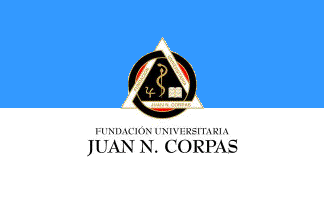 image by Ivan Sache, 06 August 2014
image by Ivan Sache, 06 August 2014
Fundación Universitaria Juan N. Corpas was established in 1970 by Dr. Jorge
Eduardo Piñeros Corpas (b. 1927), who served as Professor of Clinic Medicine,
Pharmacology and Physiology at Universidad Nacional. Corpas also founded
Fundación Clínica Hospital Juan N. Corpas (1976), Fundación Laboratorio de
Farmacología Vegetal Labfarve (1984), and Medicor.
Escuela de Medicina Juan N. Corpas started classes on 3 February 1971; the
institute was officially recognized by Resolution No. 2,105 of 29 March 1974.
Fundación Universitaria Juan N. Corpas was officially recognized in 2004 as a
non-profit, private university institution. The institute is named for Dr. Juan
N. Corpas (1885-1944), Consul General of Colombia in Paris during the First
World War and Minister of Education and Public Health in 1924.
The flag of the institute is horizontally divided light blue-white with the
institute's emblem in the middle. Blue is a symbol of purity White is a symbol
of the triumph of medicine over death.
The emblem of the institute features the red disk of knowledge charged with the
equilateral triangle of justice, truth, and honor. In the middle stands
Hippocrates' staff and snake, representing the medical skills required for the
interpretation of symptoms. The book of science and the prescription are other
symbols of truth.
Sources:
http://www.juanncorpas.edu.co/la-institucion/simbolos.html -
Institute's website
http://www.juanncorpas.edu.co/noticias/noticia/articulo/internet-inalambrico-para-los-estudiantes-corpistas.html
- Photo
Ivan Sache, 06 August 2014
 image by Ivan Sache, 21 October 2014
image by Ivan Sache, 21 October 2014
Colegio Diocesano Juan Pablo II was established on 10 December 1990 in
Apartadó (Antioquia Department) by His Grace Isaías Duarte Cancino (1939-2002,
appointed in 1988 the first Bishop of Apartadó and appointed in 1995 Archbishop
of Cali, where he was murdered by two hitmen). Classes started on 8 February
1991. The school was managed from 1996 to 2009 by the Institute of the Brothers
of the Christian School (Lasallians).
The institute is named for Pope St. John Paul II (1978-2005, canonized on 27
April 2014 by Pope Francis).
The flag of the institute is horizontally divided white-blue.
Source:
http://colegiodiocesanojuanpablo.blogspot.fr/p/simbolos-institucionales-colegio.html
- Institute's blog
Ivan Sache, 21 October 2014
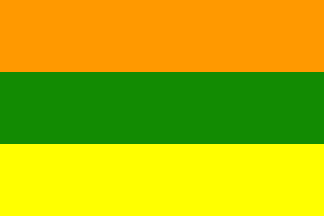 image by Ivan Sache, 11 January 2019
image by Ivan Sache, 11 January 2019
IE Juan Pablo I Paz y Futuro was established by Decree No. 247 issued on 7
April 1980 in borough Motilones, Cúcuta (Norte de Santander Department), as
Escuela Urbana Integrada Juan Pablo I, to be upgraded to Colegio Básico Juan
Pablo I by Decree No. 970 issued on 18 December 2001. The school is named for
Pope John Paul I (Albino Luciani, 1912-1978), who died 33 days after his
election and has been remembered as "the Smile of God". "Paz y Futuro" means
"Peace and Future".
The flag of IE Juan Pablo I is horizontally divided
orange-green-yellow. Orange recalls the school's philosophy, identified with its
patron saint, St. John Bosco. Green symbolizes aspiration to a better future.
Yellow represents the human resources represented by the educational community.
https://sites.google.com/site/juanpabloprimeropazyfuturo/quien-somos/himnos,
School website
Ivan Sache, 11 January 2019
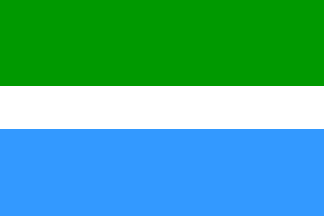 image by Ivan Sache, 10 March 2017
image by Ivan Sache, 10 March 2017
Institución Educativa Juan Sebastián de CENSA (EJSC) is based in Medellín,
with seats in Rionegro, Bello, and Itagui. CENSA, established on 29 August 2011,
is the Centro de Sistemas de Antioquia, based in Medellín with branches in
Bello, Itaguí, Caldas, Rionegro, Barbosa, El Peñol, Yarumal, Santa Fe de
Antioquia, Caucasia, and Segovia (Antioquia Department), and in Bogotá,
Manizales, and Montería, as well.
http://www.censa.edu.co - CENSA website
The flag of IEJSC is
horizontally divided green-white-blue (2:1:2). Green is a symbol of aspiration
to a better future. White is a symbol of peace and tolerance. Blue is a symbol
of harmony and confidence.
http://jscensa.edu.co/index2.php?id=26879&idmenutipo=145&tag=col -
Institute's website
Ivan Sache, 10 March 2017
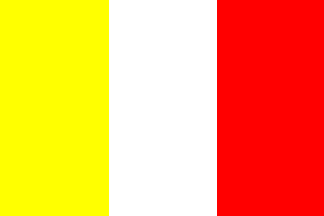 image by Jairo Alonso Méndez Méndez, 15 March 2005
image by Jairo Alonso Méndez Méndez, 15 March 2005
Here is the flag of the Colegio Departamental Julio César
Sánchez García, in Anapoima (Cundinamarca). The flag was
officialized after a concourse, in 1998, and have a version with
the 1998 Coat of Arms and 2001 Coat of Arms.
Jairo Alonso Méndez Méndez, 15 March 2005
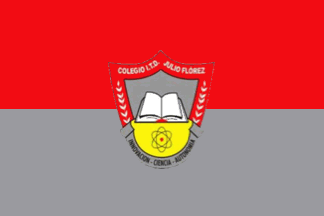 image by Ivan Sache, 11 December 2020
image by Ivan Sache, 11 December 2020
Colegio Instituto Técnico Distrital Julio Flórez was established as the
merger of Colegio Santa Rosa and Colegio Julio Flórez.
The school is named
for the Romantic poet Julio Flórez (1867-1923).
https://citdjulioflorez.edu.co/
School website
The flag of CITD Julio Flórez is horizontally divided
red-gray with the school's coat of arms in the center.
Gray, featured on
the coats of arms of the two merged schools, represents the school community's
responsibility and discipline.
Red, featured on the coat of arms of Colegio
Julio Flórez, represents autonomy as the base of education.
Yellow represents
the student's creativity, reflected in innovation and science highlighted in the
student's technical profile, also evidenced by the book and the atom's
representation.
https://citdjulioflorez.edu.co/?opcion=simbolos
Official website
Ivan Sache,
11 December 2020
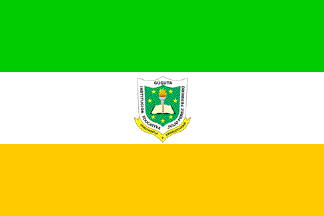 image by Ivan Sache, 03 October 2014
image by Ivan Sache, 03 October 2014
Escuela No. 10 Julio Pérez was established in 1944 in the Cundinamarca
borough, part of the municipality of Cúcuta (Norte de Santander Department). The
school was renamed Colegio Básico Julio Pérez Ferrero by Resolution No. 127 of
25 February 2000. Institución Educativa Julio Pérez Ferrero was eventually
established by Decree No. 767 of 21 July 2003, as the merger of Colegio Julio
Pérez Ferrero and Escuela San Miguel No. 13 (est. 1969). The institute is named
for the historian, journalist, and politician Julio Pérez Ferrero
(1850-1927).first President of the Assembly of Norte de Santander.
The flag of the institute is horizontally divided green-white-golden yellow,
with the institute's emblem in the middle.
Photos:
http://julioperezferrero.edu.co/portal/wp-content/uploads/wppa/884.jpg
http://julioperezferrero.edu.co/portal/wp-content/uploads/wppa/887.jpg
http://julioperezferrero.edu.co/portal/wp-content/uploads/wppa/1029.jpg
Ivan Sache, 03 October 2014
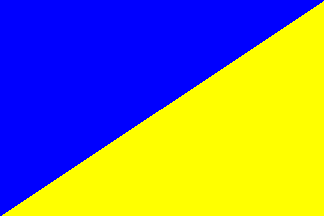 image by Ivan Sache, 18 September 2014
image by Ivan Sache, 18 September 2014
Instituto Universitario was established in Tunja (Boyacá Department) by
Agreement No. 33 of 17 October 1991, jointly signed by the municipality and
Universidad Pedagógica y Tecnológica Colombia (UPTC). The institute was renamed
Colegio Julius Sieber by Agreement No. 7 of 23 November 1992. Institución
Educativa Julius Sieber was established by Departmental Resolution No. 2,423 of
30 November 2002 as the merger of Colegio Julius Sieber, Concentración de Santa
Ana (est. in 1981), and Concentración Asís Boyacense (est. by Decree No. 54 of
13 December 1976). The institute is named for the German pedagogue Julius
Sieber, first Director of UPTC (1928).
The flag of the institute is diagonally divided indigo blue-yellow by the
ascending diagonal. Blue is the fifth colour of the solar spectrum, representing
the firmament, the night that protects those whose study all the day long for a
better future for themselves and their children. Yellow is the third colour of
the solar spectrum, representing light, life, human resources, youth, arts,
science, and knowledge.
Source:
http://iejs2012.weebly.com/bandera.html - Institute's website
Ivan Sache, 18 September 2014
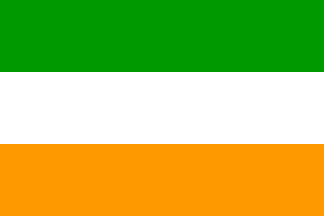 image by Ivan Sache, 12 March 2017
image by Ivan Sache, 12 March 2017
Institución Educativa Junín was established in December 1983 in the La
Esmeralda borough, with the support of the commander of the Junín military base.
The management of the institute was transferred in 1997 to the municipality.
The flag of the institute is horizontally divided green-white-orange. Green
is a symbol of the great ecological reserve formed by the
neighbouring
forests and mountains. White is a symbol of peace. Orange is a symbol of the
light of knowledge.
http://iejunin.edu.co/LaInstitucion.aspx - Institute's website
Ivan Sache,
12 March 2017
Flag:
 image by Ivan Sache, 04 July 2014
image by Ivan Sache, 04 July 2014
Standard:
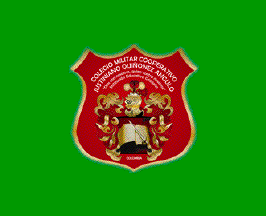 image by Ivan Sache, 04 July 2014
image by Ivan Sache, 04 July 2014
Colegio Militar Cooperativo Justiniano Quiñonez Angulo is located in the
Central borough, part of the municipality of Kennedy (Bogotá). The institute is
named for Sergeant Justiniano Quiñonez Angulo (1935-1998), a noted surgeon,
chemist, biologist and politician.
The flag of the institute is in dimensions 1.10 m x 1. 35 m, plain "hope green".
The flag's fly shall have a golden fringe of 5 cm in width. "Hope green" is a
symbol of the natural resources of the country, of the greatness of the
natural environment, of cooperativism, solidarity, friendship, excellence, and
deep Christian faith.
Source:
http://www.colegiomilitarjqa.edu.co/es/index.php?option=com_content&view=article&id=6:-bandera&catid=1:nuestro-colegio&Itemid=8
- Institute's website
The standard of the institute is similar to the flag, with the emblem of the
institute added in the middle.
Source:
http://www.colegiomilitarjqa.edu.co/es/index.php?option=com_content&view=article&id=7&Itemid=9
- Institute's website
The emblem of the institute is a red shield outlined in yellow. It shows the
arms of the Quiñonez family, dating back to the 11th century: a shield
surmounted by an helmet with red and blue (white on the image) feathers and
surrounded by red and blue (white on the image) foliage. The shield is charged
with a sword placed over an open Bible.
Source:
http://www.colegiomilitarjqa.edu.co/es/index.php?option=com_content&view=article&id=9&Itemid=11
- Institute's website
Ivan Sache, 04 July 2014